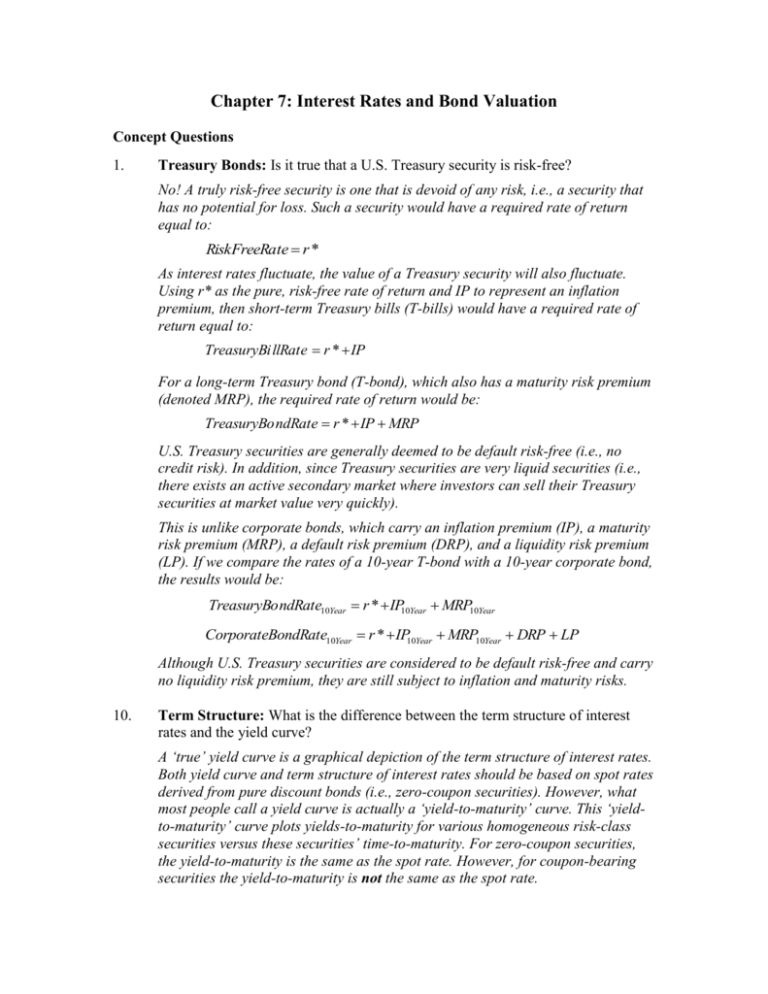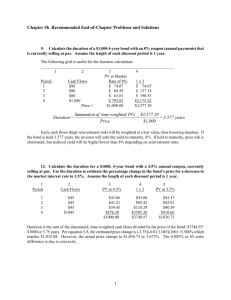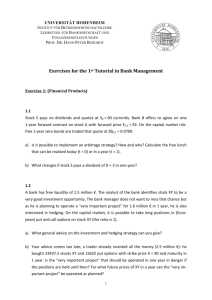RWJChapter7ProblemSolutions
advertisement

Chapter 7: Interest Rates and Bond Valuation Concept Questions 1. Treasury Bonds: Is it true that a U.S. Treasury security is risk-free? No! A truly risk-free security is one that is devoid of any risk, i.e., a security that has no potential for loss. Such a security would have a required rate of return equal to: RiskFreeRate r * As interest rates fluctuate, the value of a Treasury security will also fluctuate. Using r* as the pure, risk-free rate of return and IP to represent an inflation premium, then short-term Treasury bills (T-bills) would have a required rate of return equal to: TreasuryBi llRate r * IP For a long-term Treasury bond (T-bond), which also has a maturity risk premium (denoted MRP), the required rate of return would be: TreasuryBo ndRate r * IP MRP U.S. Treasury securities are generally deemed to be default risk-free (i.e., no credit risk). In addition, since Treasury securities are very liquid securities (i.e., there exists an active secondary market where investors can sell their Treasury securities at market value very quickly). This is unlike corporate bonds, which carry an inflation premium (IP), a maturity risk premium (MRP), a default risk premium (DRP), and a liquidity risk premium (LP). If we compare the rates of a 10-year T-bond with a 10-year corporate bond, the results would be: TreasuryBo ndRate10Year r * IP10Year MRP10Year CorporateBondRate10Year r * IP10Year MRP10Year DRP LP Although U.S. Treasury securities are considered to be default risk-free and carry no liquidity risk premium, they are still subject to inflation and maturity risks. 10. Term Structure: What is the difference between the term structure of interest rates and the yield curve? A ‘true’ yield curve is a graphical depiction of the term structure of interest rates. Both yield curve and term structure of interest rates should be based on spot rates derived from pure discount bonds (i.e., zero-coupon securities). However, what most people call a yield curve is actually a ‘yield-to-maturity’ curve. This ‘yieldto-maturity’ curve plots yields-to-maturity for various homogeneous risk-class securities versus these securities’ time-to-maturity. For zero-coupon securities, the yield-to-maturity is the same as the spot rate. However, for coupon-bearing securities the yield-to-maturity is not the same as the spot rate. Problems 3. Bond Prices: Staind, Inc., has 7.5 percent coupon bonds on the market that have 10 years left to maturity. The bonds make annual payments. If the YTM on these bonds is 8.75 percent, what is the current bond price? To find the present value of Staind, Inc.’s bond we use the following equation: 1 1 (1 r )t BondValue Staind C r F (1 r )t 1 1 (1 0.0875)10 $1,000 BondValue Staind $75 $918.8889247 (1 0.0875)10 0.0875 Using a financial calculator: 10n;8.75i;75PMT ;1,000 FV ; PV $918.8889247 4. Bond Yields: Ackerman Co. has 9 percent coupon bonds on the market with nine years left to maturity. The bonds make annual payments. If the bond currently sells for $934, what is its YTM? If we try to use formulas and solve for r, we will be unsuccessful! Therefore, using a financial calculator: 9n;90 PMT ;934CHSPV ;1,000 FV ; i 10.15300669% 6. Bond Prices: Grohl Co. issued 11-year bonds 1 years ago at a coupon rate of 6.9 percent. The bonds make semiannual payments. If the YTM on these bonds is 7.4 percent, what is the current bond price? To find the present value of Grohl’s bond we use the following equation: 1 1 r t 1 C 2 BondValueGrohl r 2 2 F (1 r )t 1 1 20 0.074 1 2 $69 $1,000 BondValueGrohl $965.1034873 20 0 . 074 2 0.074 1 2 2 Using a financial calculator: 20n; 7. 7.4 69 i; PMT ;1,000 FV ; PV $965.1034873 2 2 Bond Yields: Ngata Corp. issued 12-year bonds 2 years ago at a coupon rate of 8.4 percent. The bonds make semiannual payments. If the bonds currently sell for 105 percent of par value, what is the YTM? Again, if we try to use formulas and solve for r, we will be unsuccessful! Therefore, using a financial calculator: 84 PMT ;1,050CHSPV ;1,000 FV ; i 3.83736988% 2 7.67473975% 2 Calculating Real Rates of Return: If Treasury bills are currently paying 7 percent and the inflation rate is 3.8 percent, what is the approximate real rate of interest? What is the exact real rate? 20n; 9. The approximate relationship between nominal interest rates (R), real interest rates (r*), and inflation (h) is: R r h or r Rh r 7% 3.8% 3.2% The Fisher equation, which slows the exact relationship between nominal interest rates (R), real interest rates (r), and inflation (h) is: (1 R) (1 r )(1 h) 1 R r 1 1 h 1 0.07 r 1 3.082852% 1 0.038 13. Using Treasury Quotes: Locate the Treasury issue in Figure 7.4 on page 216 of the text (9th edition) maturing in November 2027. Is it a note or a bond? What is the coupon rate? What is its bid price? What was the previous day’s asked price? The information reported in the WSJ for this bond follows: Maturity Rate Mo/Yr 6.125 Nov 27 Bid 120:07 Asked 120:08 Ask Chg 5 Asked Yld 4.57 Since the Treasury matures in more than 10 years, it has to be a T-bond. The coupon rate is given in the first column: 6.125% The T-bond’s bid price is stated in percent of par value. The number after the colon represents the number of 32nd of the par value. Therefore 120:07 means the bond is trading at 120 7/32 of par value. If we assume the T-bond’s par value is $1,000,000, then the T-bond’s current bid price is: 7 120% % $1,000,000 (120.21875%) $1,000,000 $1,202,187.5 32 The previous day’s asked price is equal to today’s asked price minus the change in the asked price. Today’s asked price is given in column 4 as 120:08, the asked price change in column 5 as 5. Therefore, we have: 8 5 120 % % $1,000,000 $1,200,937.50 32 32 16. Interest Rate Risk: Both Bond Sam and Bond Dave have 9 percent coupons, make semiannual payments, and are priced at par value. Bond Sam has 3 years to maturity, whereas Bond Dave has 20 years to maturity. If interest rates suddenly rise by 2 percent, what is the percentage change in the price of Bond Same? Of Bond Dave? If rates were to suddenly fall by 2 percent instead, what would the percentage change in the price of Bond Sam be then? Of Bond Dave? What does this problem tell you about the interest rate risk of long-term bonds? Since both bonds currently sell at par value, their YTMs equal their coupon rate. Therefore, the current level of interest (or required rate of return on these bonds) must be 9%. If interest rates suddenly increased by 2% to 11%, the value of the each bond would be: Using a financial calculator: Bond Sam : 6n;5.5i;45PMT ;1,000 FV ; PV $950.0446969 Bond Dave : 40n;5.5i;45PMT ;1,000FV ; PV $839.5387531 The percentage change in price can be determined using the following equation: P P P 1 0 100 P0 $950.05 $1,000 PSam 100 4.995% $1,000 $839.54 $1,000 PDave 100 16.046% $1,000 If interest rates (i.e., YTMs) suddenly fall by 2% to 7%, the value of the each bond would be: Using a financial calculator: Bond Sam : 6n;3.5i;45PMT ;1,000FV ; PV $1,053.28553 Bond Dave : 40n;3.5i;45PMT ;1,000FV ; PV $1,213.550723 The percentage change in price can be determined using the following equation: P P P 1 0 100 P0 $1,053.29 $1,000 PSam 100 5.329% $1,000 $1,213.55 $1,000 PDave 100 21.355% $1,000 You should notice two items about these bonds based on the information above: (1) Holding everything else constant between these two bonds, the longer the maturity of the bond, the greater is its price sensitivity to changes in interest rates. (2) For a given change in interest rates, capital gains due to a decrease in interest rates are larger than capital losses due to an increase in interest rates. 17. Interest Rate Risk: Bond J is a 4 percent coupon bond. Bond K is a 12 percent coupon bond. Both have nine years to maturity, make semiannual payments, and have a YTM of 8 percent. If interest rates suddenly rise by 2 percent, what is the percentage price change of these bonds? What if rates suddenly fall by 2 percent instead? What does this problem tell you about interest rate risk of lower coupon bonds? Currently, both bonds have the same YTM. Therefore, their current prices are: Bond J : 18n;4i;20PMT ;1,000FV ; PV $746.8140605 Bond K : 18n;4i;60PMT ;1,000FV ; PV $1,253.185939 If the YTM increases by 2% to 10%, the bond prices are: Bond J : 18n;5i;20PMT ;1,000FV ; PV $649.3123929 Bond K :18n;5i;60PMT ;1,000FV ; PV $1,116.895869 The percentage change in price can be determined using the following equation: $649.31 $746.81 PJ 100 13.0555% $746.81 $1,116.90 $1,253.19 PK 100 10.8755% $1,253.19 If the YTM decline by 2% to 6%, the bond prices are: Bond J : 18n;3i;20PMT ;1,000FV ; PV $862.4648692 Bond K : 18n;3i;60PMT ;1,000FV ; PV $1,412.605392 The percentage change in price can be determined using the following equation: $862.46 $746.81 PJ 100 15.4859% $746.81 $1,412.61 $1,253.19 PK 100 12.7211% $1,253.19 You should notice two items about these bonds based on the information above: (1) Holding everything else constant between these two bonds, the lower the coupon rate of the bond, the greater is its price sensitivity to changes in interest rates. (2) For a given change in interest rates, capital gains due to a decrease in interest rates are larger than capital losses due to an increase in interest rates. 20. Accrued Interest: You purchase a bond with an invoice price of $968. The bond has a coupon rate of 7.4 percent, and there are four months to the next semiannual coupon date. What is the clean price of the bond? The accrued interest is the coupon payment for the period times the fraction of the period that has passed since the last coupon payment. Since we have a semiannual coupon bond, the coupon payment is one-half of the annual coupon payment payable every six months. There are five months until the next coupon payment, so one month has passed since the last coupon payment. The accrued interest for the bond is: AccruedInterest $74 2 $12.3333333 2 6 And we calculate the clean price using the following equation: Clean Pr ice Dirty Pr ice AccruedInterest Clean Pr ice $968 $12.33 $955.67 23. Using Bond Quotes: Suppose the following bond quotes for IOU Corporation appear in the financial page of today’s newspaper. Assume the bond has a face value of $1,000 and the current date is April 15, 2009. What is the yield to maturity of the bond? What is the current yield? What is the yield to maturity on a comparable U.S. Treasury issue? Company (Ticker) IOU (IOU) Coupon 7.2 Maturity April 15, 2023 Last Last EST Vol Price Yield (000) 108.96 ?? 1,827 The IOU bond has 14 years to maturity, so the bond’s required rate of return (or YTM) would be: Bond IOU : 28n;36PMT ;1,000FV ;1,089.60CHSPV ; i 3.1157123 2 6.2314246% The current yield can be determined using the following equation: CurrentYield $ AnnualInterestPayment Current Pr ice CurrentYie ld IOU $72 6.60793% $1,089.60 26. Zero Coupon Bonds: Suppose your company needs to raise $30 million and you want to issue 30-year bonds for this purpose. Assume the required return on your bond issue will be 8 percent, and you’re evaluating two issue alternatives: a 8 percent annual coupon bond and a zero coupon bond. Your company’s tax rate is 35 percent. a. How many of the coupon bonds would you need to issue to raise the $30 million? How many of the zeroes would you need to issue? The coupon bonds have a 8% coupon which matches the 8% required return, so they will sell at par value (assume $1,000). The number of bonds that must be sold is the amount needed divided by the bond price, so we can use the following equation: NumberOfBondsIssued TotalFunds Re quired Pr oceeds Re ceivedPerBond NumberOfBondsIssued Coupon $30,000,000 30,000 Bonds $1,000 PerBond For the zero coupon bonds, we first need to determine the price per bond: PZero ParValue (1 YTM )t PZero $1,000 $99.37733254 (1 0.08)30 Therefore, the number of zero coupon bonds needed to be issued would be: NumberOfBondsIssued ZeroCoupon $30,000,000 301,879.7067 Bonds $99.37733254 PerBond b. In 30 years, what will your company’s repayment be if you issue the coupon bonds? What if you issue zeroes? The repayment of the coupon bonds will be at par value plus the last coupon payment times the number of bonds issued: Re paymentCoupon 30,000 ($1,000 $80) $32,400,000 The repayment of the zero coupon bonds will be par value times bonds issued: Re paymentZeroCoupon 301,879.7067 $1,000 $301,979,706.70 c. Based on your answers in (a) and (b), why would you ever want to issue the zeroes? To answer, calculate the firm’s after-tax cash flows for the first year under the two different scenarios. Assume the IRS amortization rules apply for the zero coupon bonds. The total coupon payment for the coupon bonds will be the number of bonds times the coupon payment. For the cash flow of the coupon bonds, we need to account for the tax deductibility of the interest payments. To do this, we will multiply the total coupon payment times one minus the tax rate: CashFlowCoupon (30,000 Bonds ) ($80 PerBondInt erest ) (1 0.35) $1,560,000 Therefore, the company’s after-tax cash outflow each year for payment on this coupon bond is $1,560,000. For the zero coupon bonds, the first year interest payments is the difference in the price of the zero at the end of the year and the beginning of the year. The price of the zeroes in one year will be: PZero $1,000 $107.3275192 (1 0.08) 29 We have already determined the price of the zero coupon bonds at issue to be $99.37733254. Therefore, the difference in price from beginning to end of year would be: PZeroCoupon $107.3275192 $99.37733254 $7.95018666 This difference represented the first year’s interest deduction per bond. Therefore, the total cash flow for the zeroes will be the number of bonds issued times the difference in price times the tax rate. Note that we are not multiplying by one minus the tax rate as we did with the coupon bond. This is because the after-tax cash flow for the zero coupon bonds is a cash inflow! Remember, zero coupon bonds pay no interest, so the issuing firm receives a tax benefit for implied interest without having to pay out anything!! The aftertax cash inflow for the zero coupon bonds in the first year would be: CashFlowZero (301,880Bonds ) ($7.95018666PerBondInt erest ) (0.35) $840,000.82 The issuing firm would be able to deduct $840,000.82 from EBIT in the first year after issuing zero coupon bonds.







